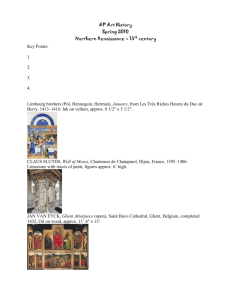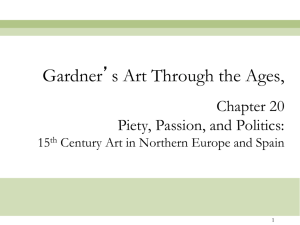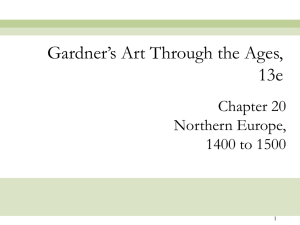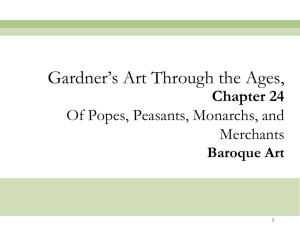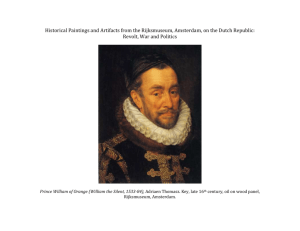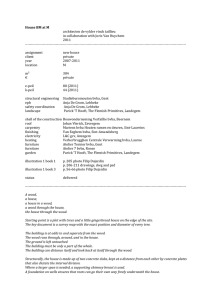Gardner's Art Through the Ages, 13e
advertisement
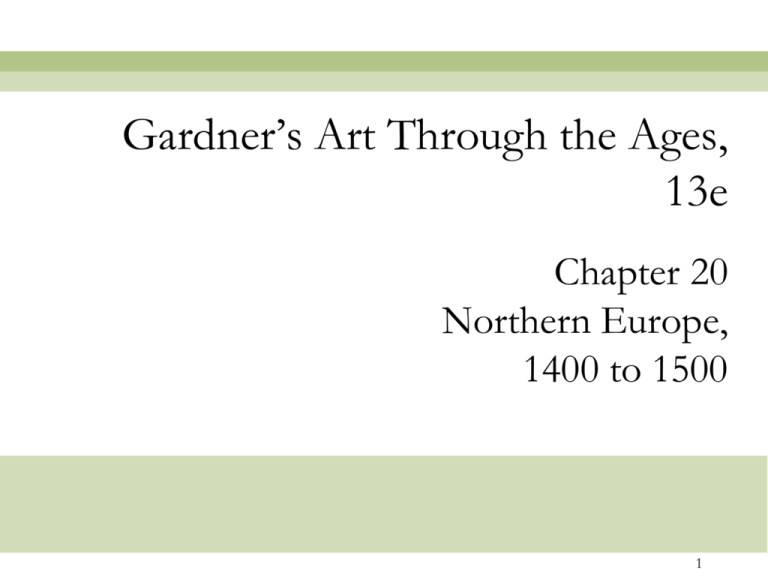
Gardner’s Art Through the Ages, 13e Chapter 20 Northern Europe, 1400 to 1500 1 Europe in the 15th Century 2 Goals • Understand the effect of political power in the development of Northern European art. • Examine the variety and types of media used in art in this period. • Identify specific artists, their respective styles, and their key works of art. • Understand the integration of sacred and secular power and wealth, along with its resultant display in art. 3 The Art of France and Flanders • Examine the effect of political power on the sumptuous art forms that developed in the 15th Century. • Examine the results of Burgundian wealth and largesse directed to art. • Understand the growth of public devotional art, the artists, new art media and new illusionistic devices developed. 4 The Very Sumptuous Hours • Examine the sumptuous art forms that developed in the 15th Century. • Explore French manuscript illumination and the new spatial and illusionistic devices used in art. 5 Figure 20-15 LIMBOURG BROTHERS (POL, JEAN, HERMAN), January, from Les Très Riches Heures du Duc de Berry, 1413–1416. Ink on vellum, approx. 8 7/8" X 5 3/8". Musée Condé, Chantilly. 6 Figure 20-16 LIMBOURG BROTHERS (POL, JEAN, HERMAN), October, from Les Très Riches Heures du Duc de Berry, 1413–1416. Ink on vellum, 8 7/8" X 5 3/8”. Musée Condé, Chantilly. 7 20-16A MASTER OF MARY OF BURGUNDY, Mary of Burgundy at Prayer, folios 14 verso and 15 recto of the Hours of Mary of Burgundy, ca. 1480. Colors and ink on parchment, illumination on left page 7 3/8” X 5 1/8”. Österreichische Nationalbibliothek, Vienna. 8 Figure 20-2 CLAUS SLUTER, Well of Moses, Chartreuse de Champmol, Dijon, France, 1395–1406. Limestone with traces of paint, Moses 6’ high. 9 20-2A CLAUS SLUTER, Virgin and Child, saints, and donors, portal of the chapel of the Chartreuse de Champmol, Dijon, France, 1385–1393. 10 Figure 20-3 MELCHIOR BROEDERLAM, Retable de Champmol. from the chapel oft he Chartreuse de Champmol, Dijon, France, installed 1399. Oil on wood, each wing 5’ 5 3/4” X 4’ 1 1/4”. Musée des Beaux-Arts, Dijon. 11 Figure 20-4 ROBERT CAMPIN (MASTER OF FLEMALLE), Merode Altarpiece (open), ca. 1425-1428. Oil on wood, center panel 2’ 1 3/8” X 2’ 7/8”, each wing 2’ 1 3/8” X 10 7/8”. Metropolitan Museum of Art, New York (The Cloisters Collection, 1956). 12 Burgundian Wealth and Art • Understand the need for sacred sculpture and new sacred art. • Examine the growth of devotional altarpieces, the media, and individual artists. 13 Figure 20-5 JAN VAN EYCK, Ghent Altarpiece (closed), Saint Bavo Cathedral, Ghent, Belgium, completed 1432. Oil on wood, 11’ 6" X 7’ 6". 14 20-5A JAN VAN EYCK, Madonna in a Church, ca. 1425–1430. Oil on wood, 1’ 1/4" X 5 1/2". Gemäldegalerie, Staatliche Museen zu Berlin, Berlin. 15 Figure 20-6 JAN VAN EYCK, Ghent Altarpiece (open), Saint Bavo Cathedral, Ghent, Belgium, completed 1432. Oil on wood, 11’ 5" X 15’ 1”. 16 Figure 20-8 ROGIER VAN DER WEYDEN, Deposition, center panel of a triptych from Notre-Dame hors-les-murs, Louvain, Belgium, ca. 1435. Oil on wood, 7’ 2 5/8" X 8’ 7 1/8". Museo del Prado, Madrid. 17 20-8A ROGIER VAN DER WEYDEN, Last Judgment Altarpiece (open), polyptych from Hôtel-Dieu, Beaune, France, ca. 1444– 1448. Oil on wood, 7’ 4 5/8” X 17’ 11”. Musée de l’Hôtel-Dieu, Beaune. 18 Figure 20-9 ROGIER VAN DER WEYDEN, Saint Luke Drawing the Virgin, ca. 1435-1440. Oil and tempera on wood, 4’ 6 1/8” X 3’ 7 5/8”. Museum of Fine Arts, Boston. (Gift of Mr. and Mrs. Henry Lee Higginson) 19 20.2 Flemish Public and Private Devotional Art • Examine the large numbers of private and public devotional art created at this time. • Identify specific artists, their respective styles and their key works of art. • Understand the relationship between religious and secular authority in the development of art. • Examine the rise of portraiture and self-portraits. 20 Flemish Public Devotional Art • Examine the complex illusionary images of the Flemish artists, especially noting the development of a single vanishing point. 21 Figure 20-12 DIRK BOUTS, Last Supper central panel of the Altarpiece of the Holy Sacrament, Saint Peter’s, Louvain, Belgium, 1464–1468. Oil on wood, 6’ X 5’. 22 20-12A DIRK BOUTS, Wrongful Beheading of the Count and Justice of Otto III, from the Stadhuis, Louvain, Belgium, ca. 1470–1475. Oil on wood, each panel 12’ 11” X 6’ 7 1/2". Musées Royaux des Beaux-Arts de Belgique, Brussels. 23 Figure 20-13 HUGO VAN DER GOES, Portinari Altarpiece (open), from Sant’Egidio, Florence, Italy, ca. 1476. Tempera and oil on wood, 8’ 3 1/2" X 10’ center panel, 8’ 3 1/2" X 4’ 7 1/2" (each wing). Galleria degli Uffizi, Florence. 24 Figure 20-14 HANS MEMLING, Virgin with Saints and Angels, center panel of the Saint John Altarpiece, Hospitaal Sint Jan, Bruges, Belgium, 1479. Oil on wood, 5’ 7 3/4" X 5’ 7 3/4" (center panel), 5’ 7 3/4" X 2’ 7 1/8" (each wing). 25 20-14A HANS MEMLING, Tommaso Portinari and Maria Baroncelli, ca. 1470. Oil on wood, each panel 1’ 5 3/8” X 1’ 1 3/8”. Metropolitan Museum of Art, New York (bequest of Benjamin Altman, 1913). 26 20-14B HANS MEMLING, Diptych of Martin van Nieuwenhove, 1487. Oil on wood, each panel 1’ 5 3/8” X 1’ 1”. Memlingmuseum, Bruges. 27 Private Images • Examine the private devotional art created at this time. • Understand the illusionistic devices in painting, the atmosphere of the private home, and the attention to symbolism. 28 Figure 20-1 JAN VAN EYCK, Giovanni Arnolfini and His Bride, 1434. Oil on wood, approx. 2’ 9" X 1’ 10 1/2". National Gallery, London. 29 Figure 20-11 PETRUS CHRISTUS, A Goldsmith in His Shop, 1449. Oil on wood, approx. 3’ 3" X 2’ 10". Metropolitan Museum of Art, New York (the Robert Lehman Collection, 1975). 30 Portraiture and the Growing Interest in Secular Art • Examine the rise of portraiture and self-portraits and the social and economic factors that made portraiture desirable. 31 Figure 20-7 JAN VAN EYCK, Man in a Red Turban, 1433. Oil on wood, 1’ 1 1/8” X 10 1/4". National Gallery, London. 32 Figure 20-10 ROGIER VAN DER WEYDEN, Portrait of a Lady, ca. 1460. Oil on panel, 1’ 1 3/8" X 10 1/16". National Gallery, Washington, D.C. (Andrew W. Mellon Collection). 33 15th Century French and German Art • Understand the royal court art in France and the integration of the sacred and the secular in art. • Examine the art that developed in Germany and in the Holy Roman Empire. • Comprehend the variety and types of media used in art in this period. • Identify specific artists, their respective styles, and their key works of art. • Examine the development of graphic art, especially in Germany in the 15th Century. 34 French Sacred and Secular Art • Understand royal court art and the integration of the sacred and the secular. • Identify specific artists, their styles, media and works of art. 35 Figure 20-17 JEAN FOUQUET, Melun Diptych. Étienne Chevalier and Saint Stephen, (left wing), ca. 1450. Oil on wood, 3’ 1/2” X 2’ 9 1/2”. Gemäldegalerie, Staatliche Museen, Berlin. Virgin and Child, (right wing) ca. 1451. Oil on wood, 3’ 1 1/4” X 2’ 9 1/2”. Koninklijk Museum voor Schone Kunsten, Antwerp. 36 15th Century German Art • Examine the art patronage interest in private piety and familiar themes. • Identify specific artists, styles and works of art. 37 Figure 20-20 KONRAD WITZ, Miraculous Draught of Fish, from the Altarpiece of Saint Peter, from Chapel of Notre-Dame des Maccabées in the Cathedral of Saint Peter, Geneva, Switzerland, 1444. Oil on wood, approx. 4’ 3” X 5’ 1”. Musée d’art et d’Histoire, Geneva. 38 20-20A STEFAN LOCHNER, Madonna in the Rose Garden, ca. 1440. Oil on wood, 1’ 7 7/8” X 1’ 3 3/4". Wallraf-RichartzMuseum, Cologne. 39 Figure 20-18 VEIT STOSS, The Death and Assumption of the Virgin (wings open), altar of the Virgin Mary, church of Saint Mary, Kraków, Poland, 1477–1489. Painted and gilded wood, central panel 23’ 9” high. 40 Figure 20-19 TILMAN RIEMENSCHNEIDER, The Assumption of the Virgin, center panel of the Creglingen Altarpiece, Herrgottskirche, Creglingen, Germany, ca. 1495–1499. Lindenwood, 6’ 1” wide. 41 Development of Graphic Arts • Examine the development of graphic arts, especially in Germany in the 15th Century. • Understand the processes that were developed in relief and intaglio printmaking. 42 Figure 20-21 MICHEL WOLGEMUT and shop, Tarvisium, page from the so-called Nuremberg Chronicle, 1493. Woodcut,1’ 2” X 9”. Printed by ANTON KOBERGER. 43 20-21A Buxheim Saint Christopher, 1423. Handcolored woodcut, 11 3/8” X 8 1/8”. John Rylands University Library, University of Manchester, Manchester. 44 Figure 20-22 MARTIN SCHONGAUER, Saint Anthony Tormented by Demons, ca. 1480–1490. Engraving, 1’ 1/4" X 9". Fondazione Magnani Rocca, Corte di Mamiano. 45 Discussion Questions What were some of the most important innovations in art media and spatial techniques at this time? How does the court and wealthy merchant patronage shape the content and appearance of religious and secular art? Why does the portrait – absent in art for nearly 1000 years – return in this period? 46
